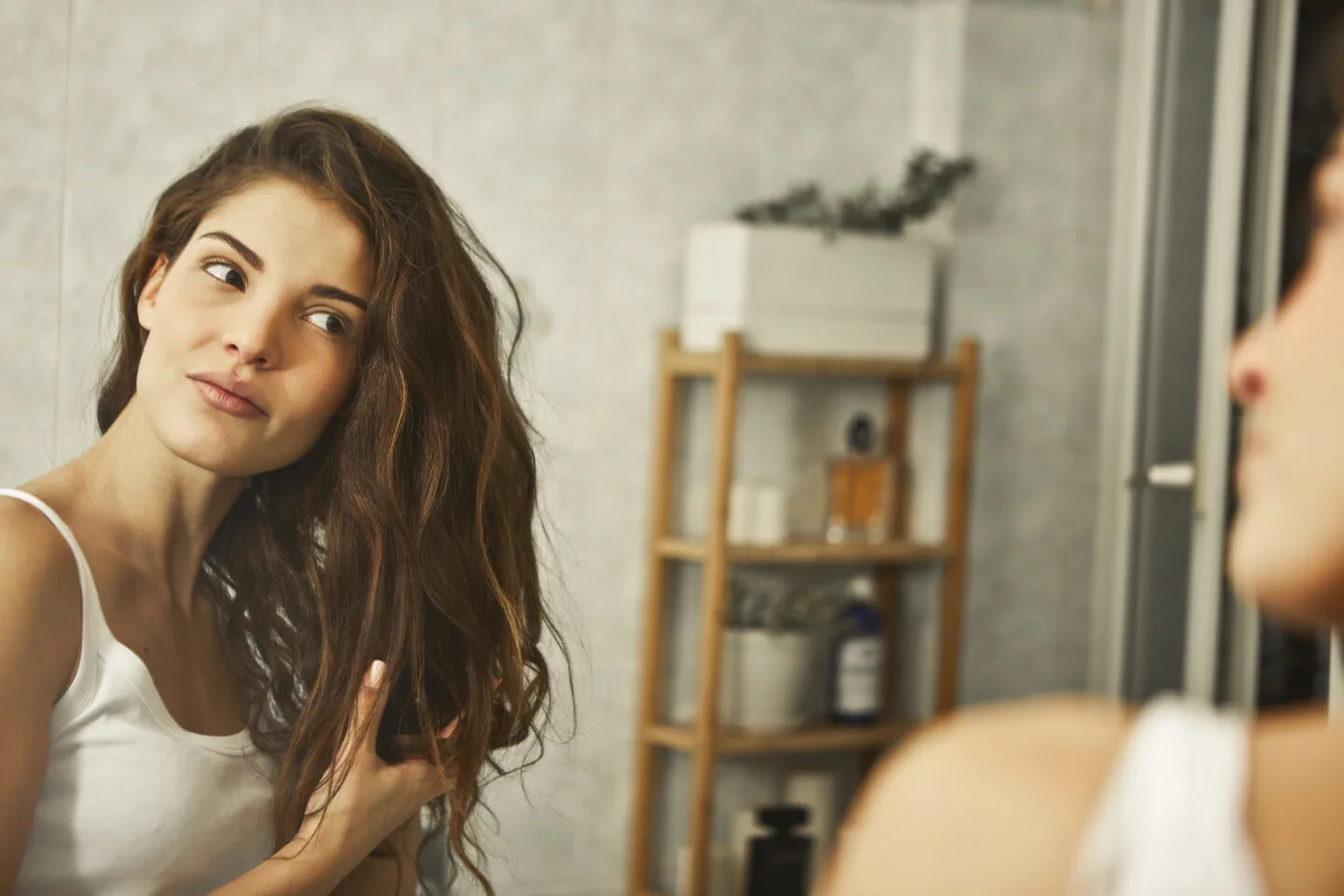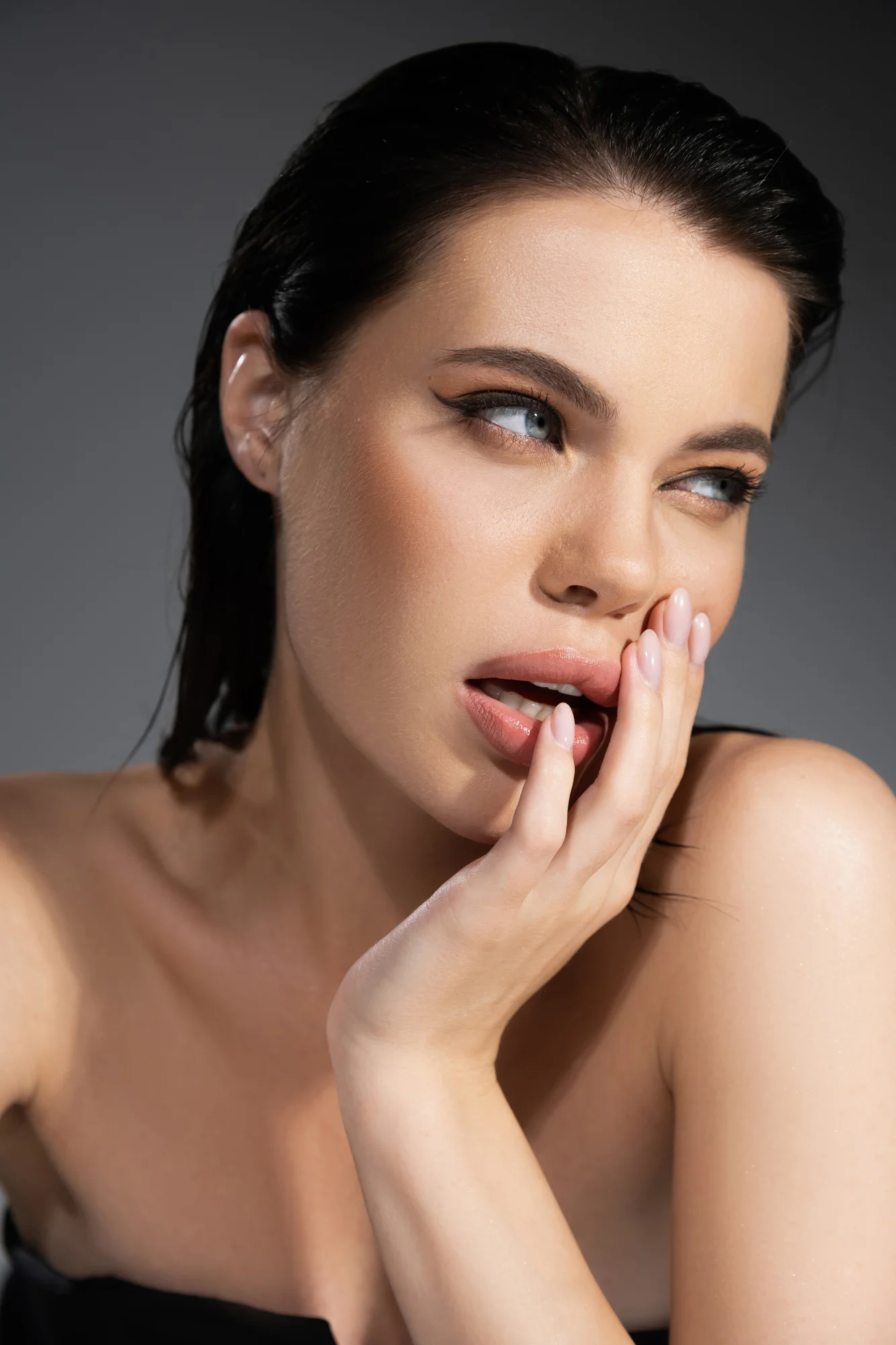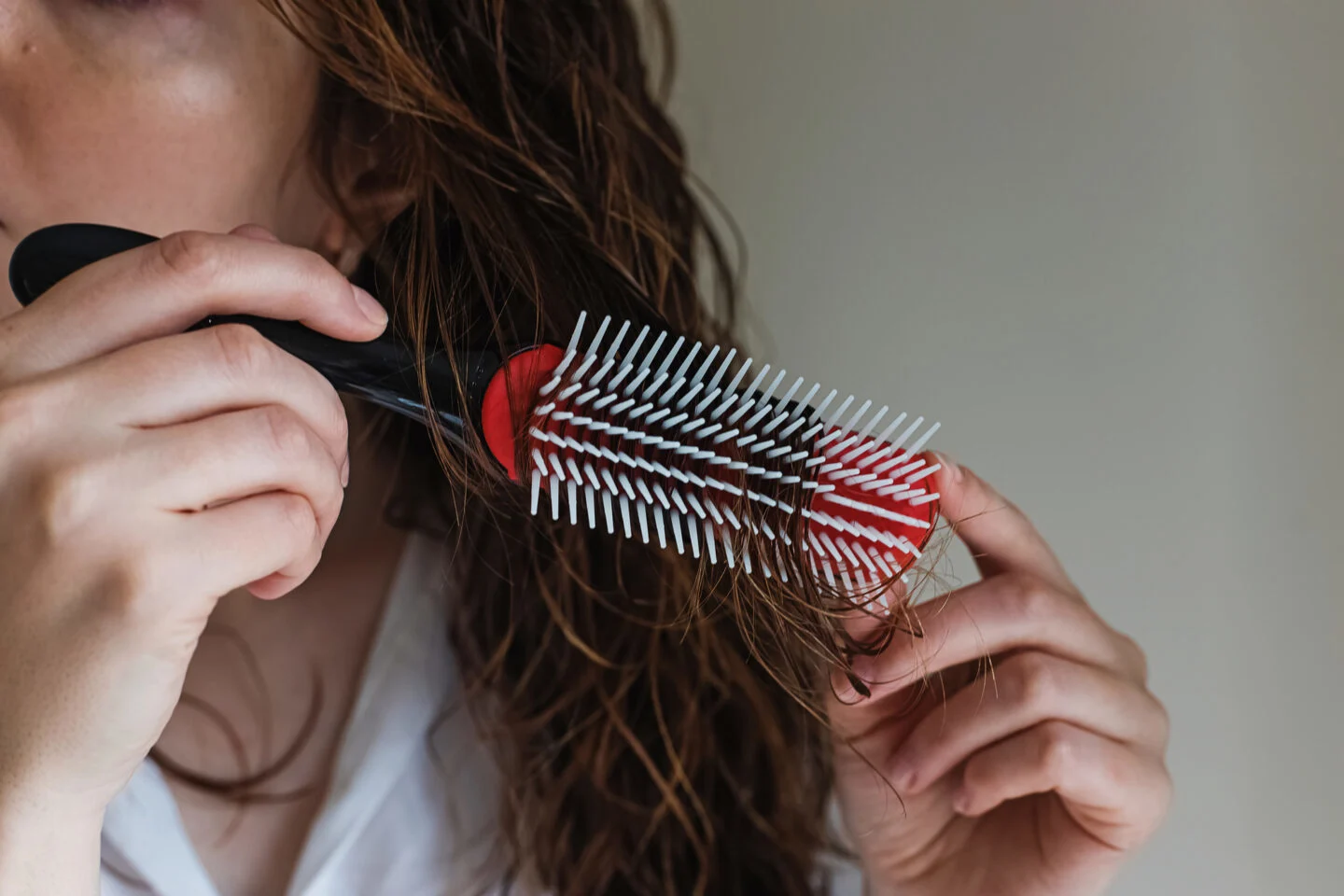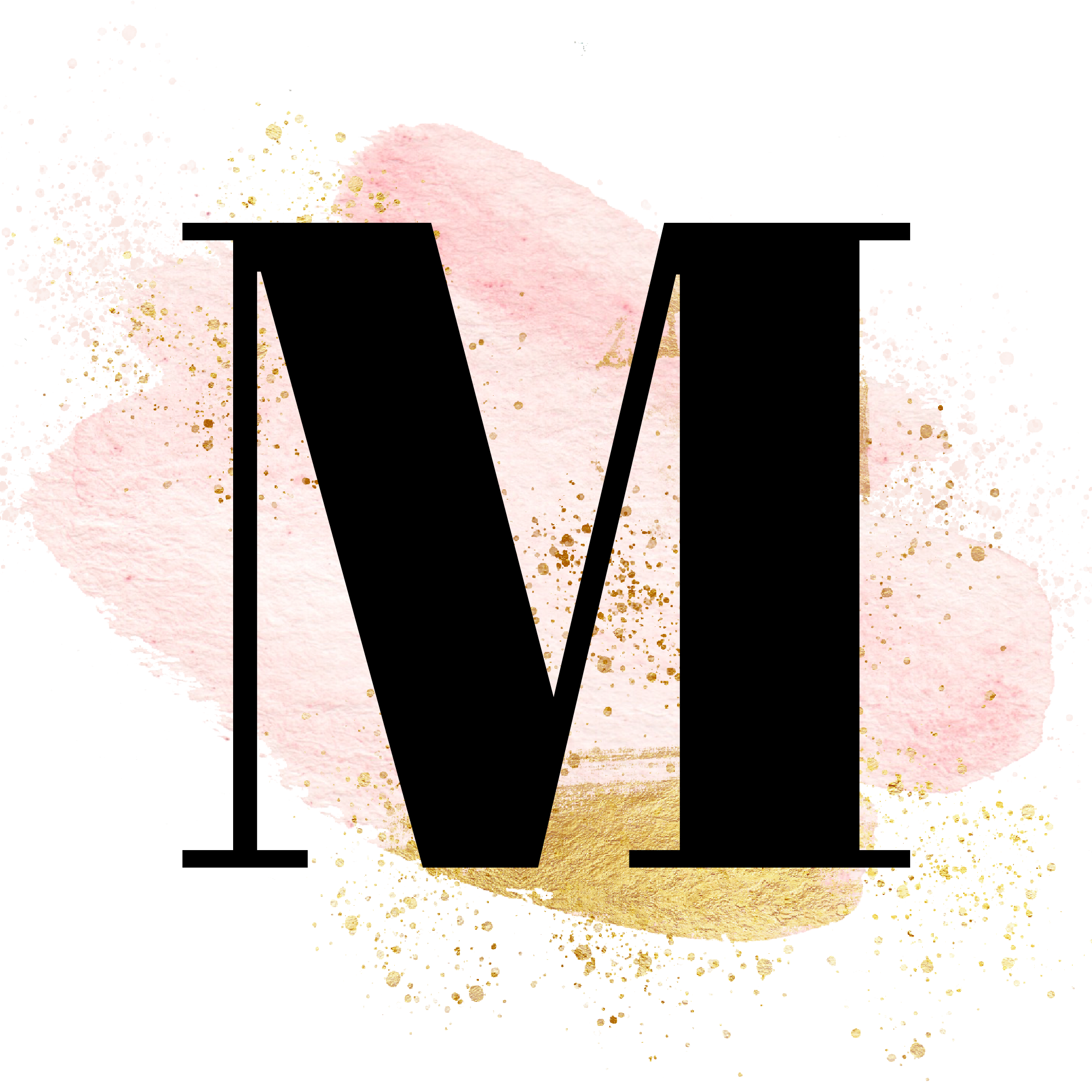Having to deal with fluffy hair after washing it can be frustrating and time consuming. If you’re looking for ways to stop your hair from going fluffy, you’ve come to the right place.
I’m going to share some simple tips and techniques that can help you keep your hair looking shiny and smooth, no matter how often you wash it, and tips on how to stop hair going fluffy after washing it.

What Does Frizzy Hair Look Like?
Frizzy hair is dry and unkempt looking. It often has a wiry texture and can stick out all over the head in an uneven, disheveled fashion.
The shape of individual strands of frizzy hair are distorted by static electricity that occurs when moisture is lacking from the follicles.
Frizzy hair appears to be unmanageable, with no smoothness or definition to it whatsoever. People with straight, curly, or wavy hair types can get frizzy if their hair care routine does not include giving their locks proper moisturizing hydration regularly.
To help prevent this common issue of dryness and lack of definition caused by humidity, it’s essential to use products specifically designed for frizz-prone locks including leave-in conditioners, curl creams, anti-frizz oils, and mousse-like lotions throughout your styling routine.
This type of targeted treatment helps keep nourishing ingredients locked in and provides extra protection against possible damage brought on by environmental factors like heat exposure or cold weather conditions that can lead to flyaways or further dehydrated tresses.
When done regularly as part of a comprehensive haircare plan, which includes avoiding overly hot showers and blow drying as much as possible.
What Causes Our Hair To Become Frizzy?
Our hair can become frizzy due to a variety of factors, some of which are determined by our genetics, or our hair types, like curly hair or natural texture.
One of the main causes is when the cuticle, or outer layer of our hair strands, becomes damaged. This damage can be caused by excessive heat styling or frequent coloring and bleaching treatments.
Chemical-based products such as conditioners and styling products like hairsprays and mousses can also damage the cuticle layer, causing frizziness.
Another contributing factor is humidity in the air; when moisture from the air gets into our hair, it prevents it from laying flat – resulting in a dry, puffy look known as frizz.
Straight hair with thicker strands tend to get more affected by external factors than finer strands, since they have more surface area for humidity and other particles to cling on to.
Those with naturally curly or wavy locks are especially prone to developing frizzy tresses due to how their hair cuts across multiple layers when grown long enough.
This makes them particularly susceptible to atmospheric influences such as winds and changes in temperatures.
Aside from these preventative measures, there are certain things we can do such as avoiding excessive heat treatment (for example: blow drying), reducing your chemical treatments and investing in good quality shampoos/conditioners that help keep our hair looking sleek rather than unruly.
Which Hair Types Are Prone To Excess Frizz?
Fine hair gets particularly prone to frizziness when it is dry, damaged and weak. Thicker hair tends to be the most susceptible to frizz because the strands are naturally more porous, which allows them to absorb large amounts of moisture from the air.
People with thicker hair types often have a harder time adding natural oils, such as coconut oil or almond oil, back into their hair, which can lead to puffier and stickier-looking styles that do not hold up well in humid conditions.
Those with curly or wavy hair every face an additional challenge: if they do not use specific techniques in styling their hair products that are specifically designed for this type of texture, they risk creating unwanted frizz.
If your hair is already dry or damaged due to over-styling or heat damage, then it’s even more prone to excess frizzing.
Always check what kind of product you’re using on your hair; if you’re using harsh chemicals or sulfates, this could be causing further damage and dehydration that leads to increased frizz, making everything worse.
To prevent excess frizz in any type of hair, make sure you use deep conditioning treatments frequently and limit heat styling tools whenever possible. Oiling your scalp regularly will also help keep moisture locked into your strands and make your hair look shinier and healthier as well.

Can Your Water Type Affect How Frizzy Your Hair Is?
Yes, your water type can affect how frizzy your hair is. Harder water that contains more minerals leads to dryness in the scalp, and of course, dryness leads to frizz.
Coarse hair tends to be more prone to extreme frizz due to its thicker texture, so if you have such a hair type, it’s especially important for you to take extra care of it.
Soft water, on the other hand, does not contain as many minerals, which helps prevent dryness and therefore lessens chances of acquiring an unruly mane.
Investing in haircare products formulated with hydrating ingredients will help tame your locks and provide protection from any future potential damage.
You may also benefit from using a deep conditioning treatment once or twice per week, which can nourish and help your hair look healthier overall by providing nourishment.
What Is The Difference Between Frizzy Hair and Fluffy Hair?
Frizzy hair and fluffy hair are often confused as being the same type of look. However, there is a distinct difference between these two types of hair.
Frizz is caused by damage to the cuticle layer of the hair shaft from excessive heat styling, chemical treatments or lack of moisture.
As such, it will appear dry, brittle and rough with split ends or flyaway strands that cause a “frizzy” appearance.
Whereas, fluffy hair is created when shorter hairs stand up away from the scalp due to slightly raised cuticles, which create volume and lift.
Fluffy locks will appear light and airy with lots of texture, whereas frayed strands will feel harsh to touch.
Maintaining both looks is entirely different; frizzy tresses require nourishing products, while mousse or sea salt spray should be used on fluffy manes to maintain body and shape without causing too much damage.
Why Does My Hair Become Fluffy Whenever I Wash It?
Hair becomes fluffy when it is washed because the cuticles of your hair are in an open or raised state, which causes your hair to become frizzy.
This is especially common with people who already have naturally wavy or curly hair, although even straight haired people may experience this.
Damage to your hair can cause the cuticles of the outer layer to weak and more likely to become frizzy.
This damage can be caused by a variety of factors such as over-processing with heat, lack of moisture, improper brushing and not using protective styling techniques.
Knowing what the cause of frizzy hair can help you prevent it from happening in the future.
The best way to keep your hair smooth and healthy is by ensuring that you use haircare products designed for your specific hair type, avoid excessive heat styling and make sure that you are regularly conditioning your hair to ensure adequate moisture levels.
Another great way to help prevent damage to your hair is by using protective hairstyles like braids that contain less manipulation daily and less exposure to environmental elements like wind, humidity or sun exposure.

How To Stop Hair Going Fluffy After Washing It
One of the most frustrating hair issues is trying to stop frizzy hair after washing it. But fear not, there are some tips and tricks that can help you keep your locks looking fabulously smooth.
For starters, knowing how to stop frizz before it even starts helps a great deal. If your hair is naturally prone to this issue, then it’s important to know the right way to care for your tresses to avoid any unwanted puffiness or unruliness.
Firstly, use a shampoo and conditioner specifically designed for frizz-prone hair types. Sulfate free products work best as sulfur-heavy shampoos can be too drying for certain hair types, which may cause further damage leading to an increase in frizz.
When conditioning, make sure extra attention is paid to treating strands with extra moisture by combing through with a wide tooth comb so as not to further rough up cuticles that lay flat when wet; this ensures a smoother finish all around after blow drying and styling.
Second instinct might be to reach for the straightener – but don’t. Trying excessive heat on fragile locks will often do more harm than good.
Instead using cold air from the blow dryer when styling goes much further in avoiding excess frizz forming after you have washed your hair.
To aid this process, use mousse or heat protectant oil beforehand as they contain nourishing ingredients like coconut oil whilst offering protection against damaging elements such as humidity which causes frizzy hair when left unprotected outdoors or indoors depending on particle levels of moisture in the air etc.
If these techniques still don’t seem effective enough, then considering investing in quality haircare products enriched with natural oils.
Plus vitamins and minerals such as omegas 3 and 6 which provide intense nourishment plus hydration resulting in smoother shinier more manageable hairstyles day-to-day with little fuss keeping those pesky flyaways at bay.
What Type Of Hairbrush Or Comb Is Best For Taming Fluffy Hair?
For those with fluffy hair, finding the right brushes or comb to tame unruly locks can be a struggle.
A wide-tooth comb is typically best for detangling, as it moves easily through knots and won’t pull out strands of hair. Look for one made from plastic or wood – avoid metal combs, which can cause breakage, and issues with friction.
To smooth down flyaways, use a boar bristle brush – this natural material helps to evenly distribute oil produced by your scalp, leaving your hair glossy and frizz-free.
Finish with a soft metal paddle brush to provide maximum smoothing effects on longer hair or when styling with heated tools. With the right combination of products and tools, you’ll be able to keep even the fluffiest of manes under control.
What Are The Best Hot Tools For Taming Fluffy Hair?
When it comes to taming fluffy hair, the best hot tools one can use are styling tools. Straightening irons and curling wands are two incredibly popular styling tools that can be used for taming unruly locks.
Thanks to these heat-activated tools, one can instantly transform their hair from wild and unmanageable to smooth and sleek, straight out of the shower.
Using an Hair dryer with a diffuser is also essential for achieving a soft, fluffy look without adding frizz or static to your hair; they work by dispersing air evenly over a wide area while helping to lock in moisture on thicker strands.
High-quality hair care products should always be used alongside hot tools, since they can help protect your hair against heat damage during styling sessions.
For example, thermal protecting sprays act as a barrier between your scalp and heated tools in your damp hair; this not only minimizes the chances of burning skin, but also helps reduce the damaging effects of extreme heat on delicate strands of hair, so you don’t damage your hair, using styling tools on your hair.
Also, using hair masks can help with hair damage, hair breakage. Plus, using a hair mask can help with nourishing straight hair, too. They often leave your hair smelling incredible also.
How Can Silk Pillowcases Stop Frizzy Hair Or Fluffy Hair?
Silk pillowcases, or satin pillowcases, are a great way to help reduce frizzy hair or fluffy hair.
Since silk is naturally smooth and soft, it minimizes friction between the fibers of your hair when you sleep, reducing damage caused by repeated movement against a rough surface like cotton.
Silk also has some elements that help keep moisture in the hair, which helps protect it from becoming dry and frizzy.
It is important to choose purely a silk pillowcase, or a satin pillow case rather than a mixture, as other materials may not be as effective. Also, look for certified hypoallergenic pillow cases with natural dyes, which do not contain any toxins and are good for sensitive skin.
Is Hot Water Or Cold Water Better To Prevent Frizzy Hair?
It is commonly assumed that cold water is better for taming frizzy hair than hot water; however, this isn’t necessarily true when deciding on your water temperature, and opting for a cold water rinse.
Hot water can help to stop frizzy hair and actually make your hair less dry, but it’s important to know how to use it correctly.
When washing your hair with hot water, only apply the hot water onto the scalp and roots of your hair. Once the regular shampoo has lathered up on the scalp and roots of your hair, switch to a colder temperature and let this lather gently run down the ends of your hair.
After rinsing out all of the shampoo from your locks, rinse off with cold or lukewarm water so that all remaining traces of shampoo have been washed away.
This way you can also avoid further dehydrating and damaging your scalp with extreme temperatures while still allowing some moisture into the ends of your frizz prone strands.
Lastly, never brush or brush vigorously right after showering as this will disrupt hair cuticles that are already raised due to wetness in humidity, which causes more frizziness on top of what you already had before washing.
How To Stop Frizzy Hair After Washing By Allowing Your Hair To Air Dry
Stopping frizzy hair after washing begins with allowing your hair cuticle to air dry instead of using heat-styling tools to dry your hair.
Wet naturally frizzy hair is much more prone to damage than dry hair, and excessive heat from blow dryers / hair dryers or straighteners can cause the cuticle of the hair shaft to become dry and brittle, resulting in split ends and frizz.
When you let your towel-dried wet hair with a microfiber towel, air dry naturally, the natural humidity in the environment helps seal the outermost layer of each strand, making your locks smoother and shinier than if they had been dried with a hot appliance.
To promote even further smoothing during drying time, finish towel drying by gently running a wide-toothed comb through your tresses while still wet. This will separate any clumps to allow more airflow when it’s hung loosely over your shoulders.
To avoid flyaways, consider finishing off with a hair serum or spray product designed specifically for adding shine and controlling frizz.
As an alternative to styling products, you can try massaging some coconut or olive oil into wet strands before drying; this is especially beneficial for people who have high porosity or coarse textured hairs because such oils penetrate deeper into shafts that are raised cuticles due to excess moisture loss from porous strands.

Having frizzy hair can be frustrating, but with the right products and techniques, it is possible to tame it. Start by washing your hair with lukewarm water and a gentle shampoo designed for frizzy hair. After rinsing, apply a leave-in conditioner or serum to help reduce frizz.
Letting your healthy hair air dry is a great option, but be sure to towel dry it first and avoid using heat styling tools.
If you’re dealing with annoying baby hairs, a boar bristle brush can help to smooth them down. Finally, argan oil is an excellent choice for taming frizz while also adding shine and moisture to your hair.

Hi, my name is Gemma, and I’m the owner of MakeupMuddle.com. I’m a true beauty obsessive, and love writing about anything to do with beauty – I have been a beauty writer since 2012.
